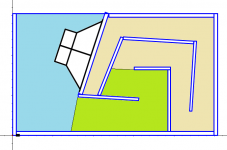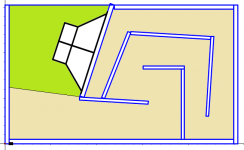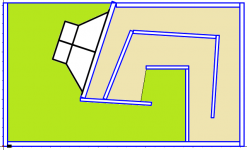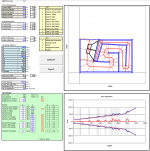I'm about to get a new subwoofer. I have already made my mind on buying a Behringer NX3000D because they are cheap here in the EU and it has good enough DSP.
I thought about three different subwoofer designs for the best bang for the buck:
Lilmike's LilWrecker
Lilmike's Cinema F-20
and a tuba THT?
I came to the conclusion that the Cinema F-20 was probably the best one for me. It is probably the easiest one to build, it has the least distortion, but most importantly it uses the Dayton Audio RSS390HF that I actually can buy. I thought about the lilwrecker because it goes lower and maybe louder?, but the cheapest driver for that one is an Alpine 15" that isn't available anymore reasonably. I've also heard that the lilwrecker doesn't play that high, and as I only have B&W DM602 "bookshelf" speakers, I would like a little higher response.
Now comes my question. Would it be possible to easily lower the tune of the F-20 by like making one side longer or just by some easy mod to the design? From what I understood the F-20 was measured in a room and only played down to about 20hz. This is mostly for movie use so I would like it to go a little closer to 15hz or maybe even lower. I do have the DSP, but massively increasing very low notes isn't probably a good idea.
I thought about three different subwoofer designs for the best bang for the buck:
Lilmike's LilWrecker
Lilmike's Cinema F-20
and a tuba THT?
I came to the conclusion that the Cinema F-20 was probably the best one for me. It is probably the easiest one to build, it has the least distortion, but most importantly it uses the Dayton Audio RSS390HF that I actually can buy. I thought about the lilwrecker because it goes lower and maybe louder?, but the cheapest driver for that one is an Alpine 15" that isn't available anymore reasonably. I've also heard that the lilwrecker doesn't play that high, and as I only have B&W DM602 "bookshelf" speakers, I would like a little higher response.
Now comes my question. Would it be possible to easily lower the tune of the F-20 by like making one side longer or just by some easy mod to the design? From what I understood the F-20 was measured in a room and only played down to about 20hz. This is mostly for movie use so I would like it to go a little closer to 15hz or maybe even lower. I do have the DSP, but massively increasing very low notes isn't probably a good idea.
I heard it was max SPL, extension and size, pick two.
These are very big subwoofer boxes and I have the room so I thought that i could increase the size to gain on max SPL and/or extension.
I don't mean that it has to go very high, maybe 80-120hz, but I heard that the lilwrecker does like 60hz, and the DM602 start already dipping above 60hz.
These are very big subwoofer boxes and I have the room so I thought that i could increase the size to gain on max SPL and/or extension.
I don't mean that it has to go very high, maybe 80-120hz, but I heard that the lilwrecker does like 60hz, and the DM602 start already dipping above 60hz.
Last edited:
If you increase the path length and make the horn go lower it will not go as high. If you look at the F-20 its already only capable of 80 Hz before there are peaks in the response
Lilmike's Cinema F-20 - AVS Forum | Home Theater Discussions And Reviews
If you have the space you could build a very large front loaded horn like the BC218:
https://www.danleysoundlabs.com/wp-content/uploads/2015/01/BC-218-spec-sheet-2.pdf
that could cover the range you want (15Hz - 120Hz) but would be huge.
Lilmike's Cinema F-20 - AVS Forum | Home Theater Discussions And Reviews
If you have the space you could build a very large front loaded horn like the BC218:
https://www.danleysoundlabs.com/wp-content/uploads/2015/01/BC-218-spec-sheet-2.pdf
that could cover the range you want (15Hz - 120Hz) but would be huge.
The Cinema F-20 does still look pretty easy to DSP with the inuke amp though. That BC218 looks really nice, but is a lot more expensive and weighs more than 2 persons can lift together.
I wasn't suggesting you bought a BC218 but made a front loaded horn like it (although probably with a single 15" rather than 2*18 to reduce size). Depending on the cost of materials it could be a cost effective way of getting a lot of output in the frequency range you want. However it would be huge. What is your target SPL and available space?
Figured I'd chime in. I'm lilmike over at AVS, the OP mentioned a few of my designs.
The main reason the F-20 is the size it is? The limitations of the driver I used.
Like most of my efforts, the F-20 design was all about compromise. I had to take into account what the driver can actually do, and come up with a cabinet that people can put in their room, and I had to make sure that the performance was worth the additional effort. When you lower the tune without increasing the size commensurately, you also lower the efficiency. The lower tune increases the excursion requirements from the driver too, so you run into the physical limits of the driver that much sooner.
The F-20 was designed to be an easy to build horn that got the most out of a surplus Eminence-made 15" driver. Here we are 8 years on, still talking about it. I think it does pretty well for what it is. That 15 was a pretty solid driver, but 300 watts in an F-20 was about all it could take. There is a hint of compression in the highest power sweep, though I am sure I was close to the amplifier's limits too. There are other drivers that work (the Dayton Ref HF 15 and the Ultimax 15 are both known to work, I've personally measured an Ultimax 15-loaded F-20).
The LilWrecker was another exercise in compromise. That was a case of the most sub I could fit behind a friend's screen wall. Almost needed a shoehorn to get them into place. The CVX was used because they worked, I had accurate specs, and at the time, they were readily available and cheap. That's not the case any more. There are a couple driver options for the LilWrecker too, but I haven't measured anything but the CVXs personally. Can I push things lower? Sure, but just like the F-20, they are not as loud when I do so. The LilWrecker is running into driver limits too, I can't take the CVX lower without running into issues. You can see significant compression in the low frequencies during the highest power sweeps I ran, though I might have been near the amplifier limits too.
Basically, the sub cabinets I drew up were designed to get all I could out of the drivers I had on hand at the time. Are there better drivers out there today? I sure hope so, but I will leave that little quest as a project for other folks to investigate.
The main reason the F-20 is the size it is? The limitations of the driver I used.
Like most of my efforts, the F-20 design was all about compromise. I had to take into account what the driver can actually do, and come up with a cabinet that people can put in their room, and I had to make sure that the performance was worth the additional effort. When you lower the tune without increasing the size commensurately, you also lower the efficiency. The lower tune increases the excursion requirements from the driver too, so you run into the physical limits of the driver that much sooner.
The F-20 was designed to be an easy to build horn that got the most out of a surplus Eminence-made 15" driver. Here we are 8 years on, still talking about it. I think it does pretty well for what it is. That 15 was a pretty solid driver, but 300 watts in an F-20 was about all it could take. There is a hint of compression in the highest power sweep, though I am sure I was close to the amplifier's limits too. There are other drivers that work (the Dayton Ref HF 15 and the Ultimax 15 are both known to work, I've personally measured an Ultimax 15-loaded F-20).
The LilWrecker was another exercise in compromise. That was a case of the most sub I could fit behind a friend's screen wall. Almost needed a shoehorn to get them into place. The CVX was used because they worked, I had accurate specs, and at the time, they were readily available and cheap. That's not the case any more. There are a couple driver options for the LilWrecker too, but I haven't measured anything but the CVXs personally. Can I push things lower? Sure, but just like the F-20, they are not as loud when I do so. The LilWrecker is running into driver limits too, I can't take the CVX lower without running into issues. You can see significant compression in the low frequencies during the highest power sweeps I ran, though I might have been near the amplifier limits too.
Basically, the sub cabinets I drew up were designed to get all I could out of the drivers I had on hand at the time. Are there better drivers out there today? I sure hope so, but I will leave that little quest as a project for other folks to investigate.
Thank you for the replies.
Well I thought that the designes ofcourse had compromises.
The best subwoofer for me would be a box designed for my room and a good, cheap driver. But I don't happen to know any audioengineers or anyone else that would design one for me for free or just little payment.
If anyone wants to design one for me, feel free to contact me.
My room is about 5x5m and maybe 2,5-3m high, there is about a 10-20cm difference with the side walls, but allmost square. I have the one corner where the sub best fits, about 100x75cm and as high as the room, but weight limitations will come. I looked up that the lightest plywood I can get, made 2,25 sheets to ~60kg.
Yes the F-20 is still going and still a good design, but as I know that the Dayton reference Hf15 and UM15 can go lower than 20hz. If I remember correctly I modelled the HF15 to about 13hz in a 400 liters box, which is big, but still smaller than the F-20.
The thing that i want though too is high spl. I don't have a reliable dB meter so I don't actually know how many dB I need, but I thought that maybe over 110dB and closer to 120dB would be enough. I like to listen at high volumes, but mostly I want the good efficiency, so I dont need a big amp, and high max spl, so that I dont need to be scared to blow the subwoofer, especially when its hidden.
If I were to build the F-20, that is my plan, would the HF15 or UM15 be better. The Ultimax can go lower and take more power, but the reference has better efficiency and as many say musicality, and is alot cheaper.
How big exacty would a front loaded 15" horn be? How many dB and how low would it go? Would it work with the dayton or some other somewhat cheap subwoofer?
Well I thought that the designes ofcourse had compromises.
The best subwoofer for me would be a box designed for my room and a good, cheap driver. But I don't happen to know any audioengineers or anyone else that would design one for me for free or just little payment.
If anyone wants to design one for me, feel free to contact me.
My room is about 5x5m and maybe 2,5-3m high, there is about a 10-20cm difference with the side walls, but allmost square. I have the one corner where the sub best fits, about 100x75cm and as high as the room, but weight limitations will come. I looked up that the lightest plywood I can get, made 2,25 sheets to ~60kg.
Yes the F-20 is still going and still a good design, but as I know that the Dayton reference Hf15 and UM15 can go lower than 20hz. If I remember correctly I modelled the HF15 to about 13hz in a 400 liters box, which is big, but still smaller than the F-20.
The thing that i want though too is high spl. I don't have a reliable dB meter so I don't actually know how many dB I need, but I thought that maybe over 110dB and closer to 120dB would be enough. I like to listen at high volumes, but mostly I want the good efficiency, so I dont need a big amp, and high max spl, so that I dont need to be scared to blow the subwoofer, especially when its hidden.
If I were to build the F-20, that is my plan, would the HF15 or UM15 be better. The Ultimax can go lower and take more power, but the reference has better efficiency and as many say musicality, and is alot cheaper.
How big exacty would a front loaded 15" horn be? How many dB and how low would it go? Would it work with the dayton or some other somewhat cheap subwoofer?
Thank you for the replies.
Well I thought that the designes ofcourse had compromises.
The best subwoofer for me would be a box designed for my room and a good, cheap driver. But I don't happen to know any audioengineers or anyone else that would design one for me for free or just little payment.
If anyone wants to design one for me, feel free to contact me.
I don't even have enough free time to design and build my own speakers and subs at the moment.
My room is about 5x5m and maybe 2,5-3m high, there is about a 10-20cm difference with the side walls, but allmost square. I have the one corner where the sub best fits, about 100x75cm and as high as the room, but weight limitations will come. I looked up that the lightest plywood I can get, made 2,25 sheets to ~60kg.
Yes the F-20 is still going and still a good design, but as I know that the Dayton reference Hf15 and UM15 can go lower than 20hz. If I remember correctly I modelled the HF15 to about 13hz in a 400 liters box, which is big, but still smaller than the F-20.
Any speaker can play 10 Hz. The question is: How loud? The F-20 is more efficient than a ported box once you get above the horn's tune.
The thing that i want though too is high spl. I don't have a reliable dB meter so I don't actually know how many dB I need, but I thought that maybe over 110dB and closer to 120dB would be enough. I like to listen at high volumes, but mostly I want the good efficiency, so I dont need a big amp, and high max spl, so that I dont need to be scared to blow the subwoofer, especially when its hidden.
If I were to build the F-20, that is my plan, would the HF15 or UM15 be better. The Ultimax can go lower and take more power, but the reference has better efficiency and as many say musicality, and is alot cheaper.
Both are good drivers. The Ultimax takes a bit more power, people I trust say that the Ref HF is lower distortion. I have no direct experience with the Ref HF.
How big exacty would a front loaded 15" horn be? How many dB and how low would it go? Would it work with the dayton or some other somewhat cheap subwoofer?
The F-20 is a front-loaded horn (technically it is an offset-driver front-loaded horn) for a 15" woofer, like the UM-15 and the Ref HF. Plans, dimensions, and measurements have been provided.
Figured I'd chime in. I'm lilmike over at AVS, the OP mentioned a few of my designs.
That "Microwrecker" looks like an interesting TH fold. I think I'll put together an optimization workbook for it, similar to what I've done for other TH folds, to make it easier to fiddle around with the dimensions to optimize them for a particular driver. Is it a single or dual expansion TH, and is it all Parabolic expansion? I can adjust the workbook to emulate conical and exponential expansions, but this may not be necessary for what's basically a narrow-bandwidth TH...
Other optimization workbooks here - The Subwoofer DIY Page - Horn Folding
I will be honest though - may favourite "fold" at the moment is the simple offset-driver TL
That "Microwrecker" looks like an interesting TH fold. I think I'll put together an optimization workbook for it, similar to what I've done for other TH folds, to make it easier to fiddle around with the dimensions to optimize them for a particular driver. Is it a single or dual expansion TH, and is it all Parabolic expansion? I can adjust the workbook to emulate conical and exponential expansions, but this may not be necessary for what's basically a narrow-bandwidth TH...
Other optimization workbooks here - The Subwoofer DIY Page - Horn Folding
I will be honest though - may favourite "fold" at the moment is the simple offset-driver TL.
Thanks. I am reasonably pleased with the MW too.
I would have to go and look at things again, but I am pretty sure that it is three parabolic segments.
PM me an email address, I will send you the sketchup files.
What about using B&C drivers in the LilWrecker, like the 15TBX100 or 15WS115? I use a pair of @littlemike MicroWrecker's in my own setup with the 15TBX100, and it's a great fit for this TH.
The 15TBX100 and 15SW115 are both excellent choices for the MicroWrecker.
Thanks. I am reasonably pleased with the MW too.
I would have to go and look at things again, but I am pretty sure that it is three parabolic segments.
Cool, I can see how the three segments can be located in the TH (see attached diagram). This actually makes things a bit easier, as I might be able to adjust the optimization routine to approximate a full parabolic, conical or exponential expansion through the TH.
Out of curiousity, just let me know the external dimensions and the thickness of the panels that you used for the build. I'm curious to see if the optimization routine comes up with and how it compares to what you designed.
Attachments
On reflection, it looks like Hornresp can't really model THs that have more than two expansions (S1-S2-S3, and S3-S4-S5), unless you can find a way to mount a driver on a board that has an angle in the middle of where the driver is mounted.
So two choices for the location for S3. The second one looks more interesting to me, as sims have done suggest that it's better when the lengths S3-S5 and S1=S3 are pretty close. I'll see if I can account for both options in the workbook.
So two choices for the location for S3. The second one looks more interesting to me, as sims have done suggest that it's better when the lengths S3-S5 and S1=S3 are pretty close. I'll see if I can account for both options in the workbook.
Attachments
Now you just need a way to make the volume in the cone and baffle cutout accounted for as part of the expansion.
Already accounted for in the workbook...
- Status
- This old topic is closed. If you want to reopen this topic, contact a moderator using the "Report Post" button.
- Home
- Loudspeakers
- Subwoofers
- Lilmike's Cinema F-20 subwoofer lower tune



